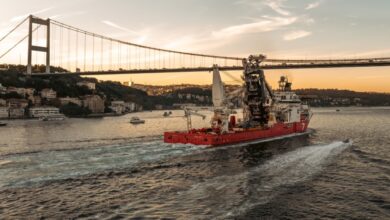Petronas conducts industry-first MPD project with high-speed drillstring telemetry
Paul Fredericks of At Balance presented the paper, which was co-authored by T Rungai and N Hudson of Petronas, R Zaeoper and O Backhaus of INTEQ, and M Hernandez of IntelliServ.
The project was an industry first, Mr Fredericks said, combining automated pressure control, pressure while drilling (PWD) and high-speed drillstring telemetry.
Major risks included kick detection, manual pressure control on the rig, shoe strength and gas plume on the moored drillship. Manual pressure control and shoe strength were considered high risk. Were the shoe to fail, large quantities of gas could have escaped up around the surface pipe and into the water column, endangering the environment, the rig and the well, along with severely damaging the reservoir. Pressure control was critical because the anticipated shallow gas could rise to the surface within minutes, before conventional procedures could detect the kick.
Petronas’ pressure-control requirement was for an automated system operating in real time during drilling connections and kicks. The operator sought a system capable of detecting kicks within minutes, Mr Fredericks said.
The multi-pronged solution included:
• Automated real-time pressure control while drilling, making connections and during a kick.
• Micro kick detection.
• Automated kick control.
• Real-time BHP readings.
Because conventional systems could not meet these requirements, Mr Fredericks said, Petronas selected:
• Managed pressure drilling for pressure control.
• Pressure while drilling (PWD) for accurate downhole pressure information.
• High data rate drillstring telemetry to transmit BHP data in real time.
• Coriolis flow meter and trending software for micro kick detection.
• Controlled drilling to detect any influx promptly.
In preparing for the job, the Dynamic Annular Pressure Control (DAPC) system was modified to receive and use the real-time PWD system. Further, the MWD system was modified to interface with the high-speed telemetry drillstring.
Further, rig surveys were employed to ensure that the MPD equipment, such as the rotating control device (RCD) could be accommodated on board. Petronas also worked on HAZID/HAZOP to reduce risk as much as possible.
Finally, a three-level training program was conducted in MPD operations.
The paper elaborates on numerous lessons learned and conclusions. In particular, Mr Fredericks stressed the value of in-depth, pre-operation training. “I can’t emphasize enough the importance of this,” he said.
The project was conducted without lost-time incidents, he said.




